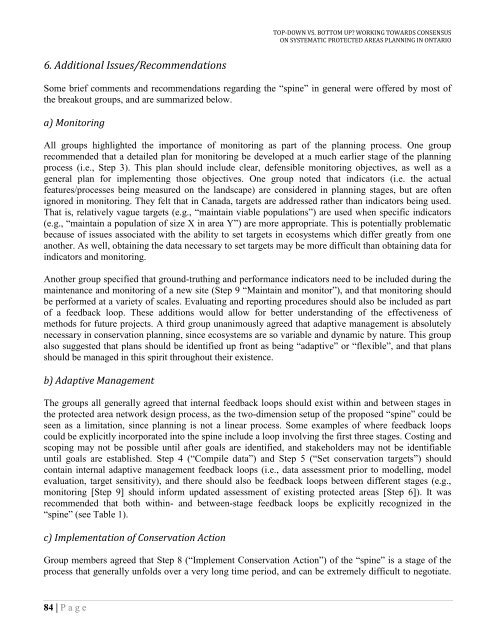Top-Down vs. Bottom Up: Working Towards Consensus ... - CASIOPA
Top-Down vs. Bottom Up: Working Towards Consensus ... - CASIOPA
Top-Down vs. Bottom Up: Working Towards Consensus ... - CASIOPA
- No tags were found...
Create successful ePaper yourself
Turn your PDF publications into a flip-book with our unique Google optimized e-Paper software.
TOP-DOWN VS. BOTTOM UP? WORKING TOWARDS CONSENSUSON SYSTEMATIC PROTECTED AREAS PLANNING IN ONTARIO6. Additional Issues/RecommendationsSome brief comments and recommendations regarding the “spine” in general were offered by most ofthe breakout groups, and are summarized below.a) MonitoringAll groups highlighted the importance of monitoring as part of the planning process. One grouprecommended that a detailed plan for monitoring be developed at a much earlier stage of the planningprocess (i.e., Step 3). This plan should include clear, defensible monitoring objectives, as well as ageneral plan for implementing those objectives. One group noted that indicators (i.e. the actualfeatures/processes being measured on the landscape) are considered in planning stages, but are oftenignored in monitoring. They felt that in Canada, targets are addressed rather than indicators being used.That is, relatively vague targets (e.g., “maintain viable populations”) are used when specific indicators(e.g., “maintain a population of size X in area Y”) are more appropriate. This is potentially problematicbecause of issues associated with the ability to set targets in ecosystems which differ greatly from oneanother. As well, obtaining the data necessary to set targets may be more difficult than obtaining data forindicators and monitoring.Another group specified that ground-truthing and performance indicators need to be included during themaintenance and monitoring of a new site (Step 9 “Maintain and monitor”), and that monitoring shouldbe performed at a variety of scales. Evaluating and reporting procedures should also be included as partof a feedback loop. These additions would allow for better understanding of the effectiveness ofmethods for future projects. A third group unanimously agreed that adaptive management is absolutelynecessary in conservation planning, since ecosystems are so variable and dynamic by nature. This groupalso suggested that plans should be identified up front as being “adaptive” or “flexible”, and that plansshould be managed in this spirit throughout their existence.b) Adaptive ManagementThe groups all generally agreed that internal feedback loops should exist within and between stages inthe protected area network design process, as the two-dimension setup of the proposed “spine” could beseen as a limitation, since planning is not a linear process. Some examples of where feedback loopscould be explicitly incorporated into the spine include a loop involving the first three stages. Costing andscoping may not be possible until after goals are identified, and stakeholders may not be identifiableuntil goals are established. Step 4 (“Compile data”) and Step 5 (“Set conservation targets”) shouldcontain internal adaptive management feedback loops (i.e., data assessment prior to modelling, modelevaluation, target sensitivity), and there should also be feedback loops between different stages (e.g.,monitoring [Step 9] should inform updated assessment of existing protected areas [Step 6]). It wasrecommended that both within- and between-stage feedback loops be explicitly recognized in the“spine” (see Table 1).c) Implementation of Conservation ActionGroup members agreed that Step 8 (“Implement Conservation Action”) of the “spine” is a stage of theprocess that generally unfolds over a very long time period, and can be extremely difficult to negotiate.84 | P a g e


